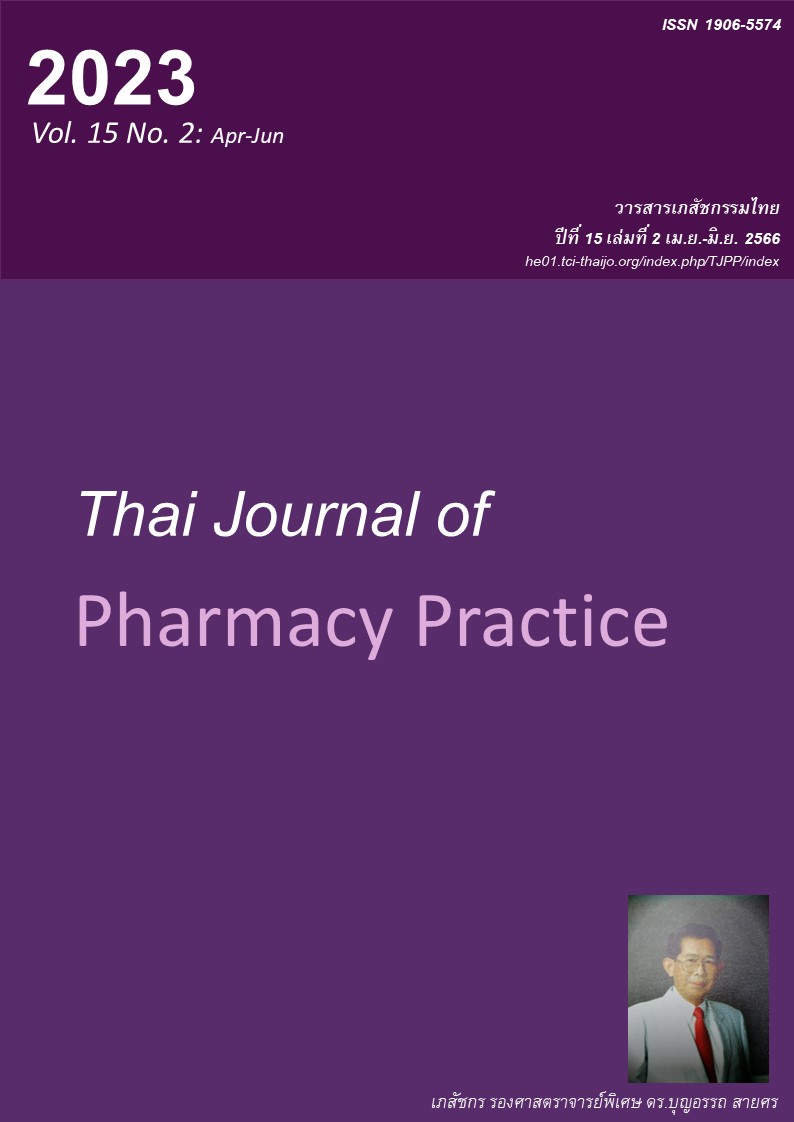การพัฒนาระบบเฝ้าระวังการจำหน่ายยาในร้านชำผ่านนโยบาย ส่งเสริมการใช้ยาอย่างสมเหตุผลในชุมชนตำบลเหล จังหวัดพังงา
Main Article Content
บทคัดย่อ
วัตถุประสงค์: เพื่อพัฒนาระบบเฝ้าระวังการจำหน่ายยาห้ามจำหน่ายในร้านชำ(การเฝ้าระวังฯ) ผ่านนโยบายส่งเสริมการใช้ยาอย่างสมเหตุผลในชุมชน (RDU community) ตำบลเหล จังหวัดพังงา วิธีการ: การวิจัยเชิงปฏิบัติการนี้ใช้กระบวนการ ตามหลักการของ RDU community ได้แก่ การประเมินชุมชน การประเมินปัญหาในพื้นที่ การคืนข้อมูลผู้ป่วยที่ได้รับผลกระทบจากยาในชุมชนโดยเภสัชกร การร่วมกันวิเคราะห์และประเมินสถานการณ์ ตลอดจนร่วมวางแผนจัดกิจกรรมซึ่งนำไปสู่การออกแบบระบบเฝ้าระวังฯ โดยเครือข่ายคุ้มครองผู้บริโภคด้านสาธารณสุข (คบส.) และการสร้างข้อตกลงร่วมกันระหว่างภาครัฐและเอกชนโดยประกาศธรรมนูญสุขภาพ การศึกษาวัดความรู้ก่อนและหลังการให้ความรู้แก่ผู้ประกอบการเกี่ยวกับพระราชบัญญัติยา (พรบ. ยา) และการให้ความรู้ประชาชนเกี่ยวกับการเลือกซื้อและใช้ยาที่ปลอดภัย การศึกษาแจกโปสเตอร์แสดงชนิดยาที่ขายได้และไม่ได้ในร้านชำแก่ร้านชำทุกร้าน จำนวน 27 ร้าน การศึกษาเก็บข้อมูลจำนวนร้านชำที่มีการจำหน่ายยาห้ามจำหน่าย 3 ครั้งห่างกันทุก 45 วัน ในช่วง 1 สิงหาคม 2563 – 30 ธันวาคม 2564 การวิเคราะห์ข้อมูลใช้สถิติ Mixed effects model ผลการวิจัย: หลังดำเนินกิจกรรมตามโครงการพบว่า ร้านชำจำหน่ายยาห้ามจำหน่ายลดลงอย่างมีนัยสำคัญทางสถิติจากจำนวน 20 ร้านในการตรวจครั้งที่ 1 เหลือ 6 ร้านในการตรวจประเมินครั้งที่ 3 (P<0.001) คะแนนความรู้ของผู้ประกอบการและประชาชนเพิ่มขึ้นอย่างมีนัยสำคัญทางสถิติจาก 9.59 ± 2.20 เป็น 11.67 ± 3.33 (P<0.001) (คะแนนเต็ม 16 คะแนน) และจาก 19.02±3.36 เป็น 21.92±3.37 (P<0.001) (คะแนนเต็ม 28 คะแนน) ตามลำดับ หลังจากการใช้ระบบเฝ้าระวังฯ ไม่พบการจำหน่ายยาปฏิชีวนะชนิดรับประทาน ยาสูตรผสม ยาชุด และยาหมดอายุ สรุป: การพัฒนาระบบเฝ้าระวังฯ ผ่านนโยบาย RDU community ทั้ง 5 กิจกรรม ทำให้เกิดการแก้ปัญหาในเชิงระบบ โดยเป็นการเชื่อมโยงข้อมูลระหว่างโรงพยาบาลและชุมชนภายใต้การมีส่วนร่วมของทุกภาคส่วน ระบบเฝ้าระวังฯ ทำให้ผู้ประกอบการและประชาชนเกิดความรอบรู้ในการใช้ยาอย่างสมเหตุผลและส่งเสริมให้ตำบลเหลเป็นชุมชนต้นแบบปลอดยาที่ห้ามจำหน่ายในร้านชำได้
Article Details

อนุญาตภายใต้เงื่อนไข Creative Commons Attribution-NonCommercial-NoDerivatives 4.0 International License.
ผลการวิจัยและความคิดเห็นที่ปรากฏในบทความถือเป็นความคิดเห็นและอยู่ในความรับผิดชอบของผู้นิพนธ์ มิใช่ความเห็นหรือความรับผิดชอบของกองบรรณาธิการ หรือคณะเภสัชศาสตร์ มหาวิทยาลัยสงขลานครินทร์ ทั้งนี้ไม่รวมความผิดพลาดอันเกิดจากการพิมพ์ บทความที่ได้รับการเผยแพร่โดยวารสารเภสัชกรรมไทยถือเป็นสิทธิ์ของวารสารฯ
เอกสารอ้างอิง
Health Administration Division. Rational drug use community guideline. Nonthaburi: Office of Permanent Secretary, Ministry of Public Health; 2020.
Boonyoung U, Muenpa R. Prevalence of and factors affecting inappropriate sale of drugs in grocery stores within Phitsanulok province. Thai Journal of Pharmacy Practice 2019; 11: 105-18.
Pattamasaravut P, Muenpa R. Development of model grocery stores from the civil state project on collective action for drugs safety in communities. Thai Journal of Pharmacy Practice 2020; 12: 601-11.
Wiriyanutai P. Prevalence and characteristics of groceries that provided antibiotics in Ngao District, Lampang Province. Thai Journal of Pharmacy Practice 2015; 7: 167-77.
Chaipichit N, Jarernsiripornkul N, Chumworathayi P. Knowledge, understanding of drug allergy and drug allergy card carrying behavior of drug allergic patients in Srinagarind hospital. Srinagarind Medical Journal 2009; 24: 224-30.
National Antimicrobial Resistance Surveillance, Thailand (NARST). Antimicrobial resistance in Thailand [online]. 2013 [cited Jun 20, 2021]. Availa ble from: narst.dmsc.moph.go.th/news001.html.
Health Administration Division. Model of active community surveillance in Amphor Surayang, Mahasarakam. Nonthaburi: Department of Health Service Support, Ministry of Public Health; 2019.
Kunthong P. The development of surveillance systemin grocery stores which have prohibited drug area of Phatthalung [online]. 2018 [cited Dec 25, 2020]. Available from: data.ptho.moph.go.th/ptvicha karn62/uploads/29224_0801_20190608233359.pdf.
Noisanit S, Ruengorn C. Development of a commu- nity model with no antibiotics, Yachud and steroids containing drugs: a case study in Thung Luang subdistrict municipality, Khirimat district, Sukhothai. Thai Journal of Pharmacy Practice 2021; 13: 920-32.
Chatakan W. Action research. Wichcha Journal Nakhon Si Thammarat Rajabhat University 2010; 29: 1-7.
Arparsrithongsakul S, Ploylearmsang C, Nonsaket T, Meeduang1 A, Ratchatawedchakul K. Effect of antibiotic education by using face to face communication, printed materials and folk media to people at Ban Nong-Tae Maha Sarakham province. Isan Journal of Pharmaceutical Sciences 2019; 15: 138-9.
Laverack G. Health promotion practice: power and empowerment. Berkshire: Open University Press; 2007.
Samukkethum S. Glenn Laverack’s approach to community empowerment. Journal of Social Work 2021; 29: 1-28.
Health Data Center. Population in Lea subdistrict [online]. 2021 [cited Mar 22, 2021]. Available from: pna.hdc.moph.go.th/hdc/reports/report.php?so urce=formated/pop_sex_age.php&cat_id=ac4eed1bddb23d6130746d62d2538fd0&id=710884bc8d16f755073cf194970b064a.
Sungthong W. Prevalence of grocery stores with antibiotics selling at Maesuai district, Chiang Rai province and its affecting factors. Thai Journal of Pharmacy Practice 2015; 7: 38-46.
Phupalee T, Apasrithongsakul S, Yingyod W, Sangsuwan T, Ammard L. Groceries development model with community involvement in Phon Sung Subdistrict, Sakon Nakhon. Thai Food and Drug Journal 2014; 21: 57- 63.
Attaweekun T, Pansila W, Promasatayaprot V. The development of surveillance system for dangerous drug selling in grocery store in the area of Sakaeprong sub-destrict, Muang district, in Burirum province. Christian University of Thailand Journal 2016; 22: 497-509.


